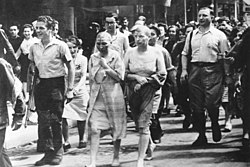Fictional
In modern fiction, shaved heads are often associated with characters who display a stern and disciplined or hardcore attitude. Examples include characters played by Yul Brynner, Vin Diesel, Samuel L. Jackson, Telly Savalas, Sigourney Weaver, and Bruce Willis, as well as characters such as Agent 47 (whose physical appearance was based on his actor, the aforementioned David Bateson), Mr. Clean, Kratos, Saitama, and Walter White. Baldness is sometimes an important part of these characters' biographies; for example, Saitama wanted to be a superhero and lost all of his hair in exchange for receiving superpowers. Shaved heads are also often associated with villains in fiction, [88] such as Ernst Stavro Blofeld, Colonel Kurtz, Lex Luthor, Thanos, Bullseye, portrayed by Colin Farrell, and Alex Macqueen's version of the Master. A notable exception is Daddy Warbucks.
A goatee, usually of the Van Dyke variety, is often worn to complement the look or add sophistication; this look was popularized in the 1990s by professional wrestler "Stone Cold" Steve Austin. For most of the crime drama series Breaking Bad , [89] Walter White (played by Bryan Cranston) wore a Van Dyke with a shaved head. [90]
In futuristic settings, shaved heads are often associated with bland uniformity, especially in sterile settings such as V for Vendetta and THX 1138 . [91] In the 1927 sci-fi film Metropolis , hundreds of extras had their heads shaved to represent the oppressed masses of a future dystopia.
It is less common for female characters to have shaved heads, though some actresses have shaved their heads [92] or used bald caps [93] for roles.







